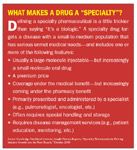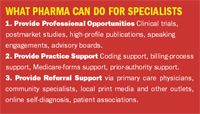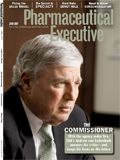A Very Specialty Moment
While the most sought-after opinion leaders are often older, well-established physicians, companies should also be aware of the rising stars. Younger, up-and-coming specialists who are beginning to publish are often more cutting-edge and open to experimental approaches.
Last September, at Bank of America's 36th Annual Investment Conference, Pfizer's new CEO, Jeffrey Kindler, made a point of singling out his company's specialty business as key to its growth plan. Kindler stated that Pfizer, the ultimate Big Pharma, is also the eighth largest biotech in the world—and aiming to become number one "in the not-too-distant future." Pfizer's biologics products would, he said, generate $1.5 billion for the company in 2006—its biologics pipeline has grown from one to 35 projects over the past decade—and he expected that revenue to triple by 2010.

Kindler is certainly not alone in identifying specialty pharmaceuticals as a strategic avenue of growth. AstraZeneca's CEO, David Brennan, recently projected that "by 2010, up to a quarter of our candidates for full-scale development will be biological therapeutic agents." True to form, the firm's record-breaking $15.6 billion deal with MedImmune in April delivered a fat crop of vaccines as well as late-stage products in oncology, infection, inflammation, and respiratory conditions—and upped the proportion of biologics in AstraZeneca's pipeline from 7 percent to 27 percent, putting it in the same company as Wyeth, Roche, and Lilly. And that's not counting small-molecule specialty products. Whether measured by the rise of biologics in pipelines, deals with large-molecule makers, or New Drug Applications (NDAs), Big Pharma has clearly gotten specialty religion. The reasons for this trend, in an industry that has long thrived on high-volume, small-molecule oral products, are complex. According to the Cambridge Healthtech Institute's Insight Pharma report "Specialty Pharmaceuticals: Driving Industry Growth into the Next Decade," pharma's shift is a strategic response to fierce pressures to reduce R&D costs, increase incremental revenue, and limit both premarket and postmarket risks.
Why Specialty Is So Special
According to IMS Health, specialty products contributed 62 percent of the market's total growth in 2006, compared with just 35 percent in 2000. The cancer market saw unprecedented R&D investment last year, not to mention 12 percent growth. Oncological-products sales are expected to reach more than $40 billion this year, and IMS predicts that it will become the largest single sector in terms of value by 2010. Major plans and payers are also reporting skyrocketing use of cytokines, recombinant products, and other biological classes. As for the total pharma pipeline, 27 percent of all compounds are biologic in nature. (For a definition of specialty products and biologics, see "What Makes a Drug a 'Specialty'?")
Revenue potential and risk management may be the prime drivers, but an industry-wide desire to improve public image is also accelerating the shift to specialty medicine. Whereas the public once prized pharma almost uniquely among businesses for its positive role in cutting-edge scientific research and lifesaving drug development, it now views the industry as a marketing juggernaut bent on maximizing revenue—even at the expense of the public's health. A barrage of negative news, ranging from drug withdrawals and rising drug prices to spinning and suppressing negative clinical data, has stretched public trust in pharma to the breaking point. In a 2004 Gallup poll that asked a sample of 518 adults to rate their perceptions of 25 industries, the pharmaceutical industry ranked 23rd—below the movie industry, advertising, accounting, automobiles, and government!

What makes a drug a "specialty"?
Although a greater emphasis on specialty drugs is anything but a quick fix, it will help get the industry back on track with its most important constituency: patients. Companies will be seen to be wrestling with important and exciting biomedical problems and producing innovative drugs that relieve the burden of disease in terms of societal cost and human suffering.
So Big Pharma's embrace of specialty markets makes sense on every level. But the verdict is out on how successful companies can actually be in exploiting the opportunity. Clearly, large-scale development and marketing of specialty products will require changes in organizational structure, resourcing priorities, alliance strategy, and stakeholder relationships. An industry reared on medicinal chemistry will not easily yield that bias. R&D managers are more comfortable with small-molecule chemistry, while the sales and marketing side is habituated to the straightforward reimbursement dynamics, pricing algorithms, physician targeting, and marketing communications of oral drugs for large primary care markets.
One thing, however, is certain: The increasing involvement of top 20 pharma companies in specialty therapeutics will usher in deep changes at both the operational and the cultural levels. The big question is which of these industry giants will find a way to be nimble and innovative enough to optimize the enormous opportunity that specialty pharmaceuticals present. And as always, bold leadership at the top will prove decisive. Kindler's and Brennan's big-time biotech boosterism is a very positive sign.

The two top focus-on-the-specialist drivers
The Specialist Is In
This deepening specialty involvement will bring Big Pharma into close contact with a key stakeholder—one with whom most large firms have had only a marginal relationship: the specialist. Mastering this new dynamic is essential. How well companies cultivate and collaborate with key opinion leader (KOL) specialists will make the difference between market success and failure. Specialists are poised to become major players in the new healthcare economy. Significant treatment advances on many serious-disease fronts will greatly expand patient populations, placing unprecedented demands on specialists in community and hospital settings (see "The Two Top Focus-on-the-Specialist Drivers".)
However, Big Pharma needs to be attuned to the differences between specialists and primary care physicians (PCPs)—in terms of their education, for example, and their accessibility—as well as the implications for marketing and detailing. Getting (and staying) up to speed on such specialist-specific complexities as practice economics, referral flows, and product reimbursement-and-utilization management is crucial for both drug developers and marketers.
To start with the easy stuff: Specialists specialize! They focus in depth on a particular disease area, while PCPs are broadly familiar with many conditions—that way, they can better treat or refer patients presenting a wide spectrum of symptoms. Specialists also see fewer patients and are not as time-pressured as PCPs. Most work in teaching hospitals or medical groups, unlike PCPs, who toil away in fast-paced managed-care organizations and see one patient every eight minutes.

What pharma can do for specialists
In terms of patient interactions, specialists generally are much more focused and go much deeper; as a result, detailers tend to have longer, more in-depth conversations about a product with a specialist. This receptivity to substantive communication flows mostly from the fact that the specialist is more clinically oriented—and more attuned to clinical findings that differentiate products—than the generalist practitioner. A successful specialty rep must be able to talk the specialist talk—and able to make a truly technical pitch, based on state-of-the-art knowledge of diseases, therapeutics, and patient needs—rather than relying on samples, incremental labeling differences, or a variety of promotional inducements.
Although the knowledge demands are considerably greater on specialty reps, other aspects of the specialist population can make specialty sales and marketing easier. Many specialties have only one or two thousand specialists, which makes for a tightly knit, largely homogeneous community. They attend the same meetings, read the same journals, and generally observe the same treatment guidelines.
For instance, neurologists from around the world go to the same annual neurology confabs—likewise for rheumatologists, pulmonologists, and oncologists. Physicians within a specialty share the same understanding of current and emerging practices and developments in the diseases they treat. This greatly simplifies sales and marketing. (Compare this profile with that of the national PCP population in the United States, which is 222,000 strong—including 91,600 family-care and general-practice physicians—and exhibits immense regional and professional variation.)
The Details of Specialty Detailing
Sales and marketing expenditures, driven up by the need to support high-volume primary care products, are rising despite a hostile environment. The window for face time with PCPs is shrinking. A McGraw-Hill Healthcare study showed that while the number of reps had more than doubled from 40,000 to 90,000 between 1996 and 2001, the number of doctors has essentially remained steady (approximately 350,000 to 400,000). Moreover, the quality of PCP detailing is diminishing with respect to access, duration of visit, physician recall, and ability to leave samples. PCPs complain about sales force overkill, and provider institutions are erecting more hurdles to limit rep access.

What specialists can do for pharma's life cycle management
In many managed care settings, sales rep access to physicians is controlled, if not prohibited. At the least, reps have to negotiate with receptionists and nurses to get through the door to the MD. Once they gain access, reps are lucky to get a full seven minutes for their troubles. Many of their time-tested tools, such as samples, promotional gifts, and complimentary events (dinners, conferences, etc.), are limited or proscribed by PhRMA's Code of Interaction or the recently promulgated OIG guidelines.
In any case, there is considerable evidence that the power of drug samples, a mainstay of PCP detailing, has been waning. A 2003 IMS Health sample-tracking survey found that only 36 percent of samples were actually delivered to the target physician. These challenges are compounded by the fact that the samples in primary care reps' bags are me-too drugs offering only marginal advances. Moreover, armies of reps from competing companies—to say nothing of multiple details from the same company, often for the same drug (a phenomenon one physician calls "the spam effect")—are wearing the patience of harried physicians. By contrast, the less-time-pressured specialist is likely more welcoming of a substantive clinical detail. Samples are not an element in specialty reps' marketing mix.
Finally, although the fully loaded annual cost per specialty drug rep is, at $330,000, substantially higher than for a primary care rep, specialty sales forces are considerably smaller and more productive on a per-rep basis. Where the top 10 pharma companies ranged from $1.6 million in sales per rep (Sanofi-Aventis, Novartis, Abbott, Lilly) to $2.9 million (Pfizer), the top three biotech companies ranged from $3 million in sales per rep (Biogen Idec) to $9 million (Amgen).
The Specialist-Focused Mutual-Support Strategy
Any successful specialty-care business franchise will incorporate specialist expertise into every stage of a product's life cycle, from early in discovery to long after the launch. Establishing ongoing connections to KOL specialists should be a priority from the moment a company decides to enter a specialty-disease category. Moreover, this focus must be shared by the entire therapeutic franchise—clinical, business development, marketing, patient support. Pharma teams need to develop approaches that will create equity with the most forward-thinking and respected medical authorities in a way that benefits all stakeholders (see "What Specialists Can Do for Pharma's Life cycle Management")
Specialties are generally organized by subspecialty: Neurological disorders are, for instance, motor or cognitive in nature. Connective-tissue diseases are a subset of autoimmune disorders, which in turn fall under the general immunity category. Many subspecialty disease areas may have as many as 500 thought-leading physicians who, through their research, expertise, or leadership, wield great influence over research, drug development, and medical practice in their field. Some 100 usually stand out as movers and shakers—the ones who head academic departments, serve on national associations, even advise federal agencies like FDA. These are the physicians who define the standard of care.
As fate and the free market would have it, perhaps 80 out of these 100 have not already been tied down by commitments to other companies. A specialist-focused strategy requires that a company develop a plan for building relationships with each one. While the most sought-after KOLs are often older, well-established physicians, companies should also be aware of the rising stars. Younger, up-and-coming specialists who are beginning to publish are often more open to experimental approaches and current with the latest "-omics" technologies. They also may be hungrier—and more interested in opportunities to lead clinical trials or serve on scientific advisory boards.
Building relationships with both established and emerging KOLs enables a company to approach another party with intellectual-property rights to a new molecule. If the compound promises to meet an important patient need, these specialists are likely to be highly motivated to participate in the clinical stage of drug development—by offering advice about end point selection, trial design, and patient enrollment. Often they will want to be in charge of Phase III trial sites in order to give as many of their patients as possible a shot at the new treatment. If they are pleased with the drug's performance, they will be among its most powerful boosters, raising awareness among colleagues, payers, investors, and patient associations.
Of course, it goes without saying that nothing gets the attention of KOL physicians like having the best-in-class molecule—they will welcome the chance to get it to their patients.
Meanwhile, the medical staff of the drug company is working with the specialists to line up speakers' bureau engagements, publication in peer-reviewed journals, and a range of services and opportunities to generate a referral flow to their practice. At its best, this relationship is a mutually supportive model between the KOL and the drug developer.
The type of specialist on whom interaction is focused changes throughout the drug-development cycle. The most influential—the academic "super-specialists"—are most valuable in the early stages of discovery and preclinical development when a company is pressure-testing a mechanism of action, say, or grappling with cellular pathways and optimal targets. But as the product nears launch, the high-prescribing opinion-leading specialists with more clinical experience rise in importance because they can generate business. Postlaunch, some specialists are valued because of their regional influence. Transitioning to the right KOLs at the right time in the development cycle requires smart deployment of resources.
When recruiting specialists for clinical-trials research, companies often do a poor job of balancing the investigator selection needs of the medical and marketing groups. The clinical-development team typically wants doctors who have a track record in conducting GCP (good clinical practice) trials and enrolling patients. Marketing tends to want to bring in the KOLs who can attract attention, network, and use their influence to boost enrollment or get trial results published in prestigious journals.
Once a therapeutic area manager has determined how the KOLs define success—be it professional standing, business opportunities, or contributions to society—he or she is ready to incentivize the system (see "What Pharma Can Do for Specialists"). Once these specialist relationships are in place, franchise managers have a core physician base awaiting their product's launch. Moreover, that base will ignite awareness and high regard among the wider specialist prescribing base. The same formula can be replicated in Europe, Asia, and other markets.
Market forces are aligned to favor the ascendency of specialists and of specialty medicine. The skyrocketing sales and use of specialty products have become a cliché. The institutional changes hinted at here will come in fits and starts, but they will come. All that remains to be seen is which industry giants will adapt their traditions and overcome their biases to succeed in making the most of this historic opportunity.
It may be that the big biopharmaceutical contenders such as Amgen or Genentech will prove more adept at managing market segments—and vault into the top tier of companies. After all, these companies understand the world of the specialist and have a track record of collaboration often going back a decade or so.
But Pfizer's Jeffrey Kindler and AstraZeneca's David Brennan have certainly thrown down the gauntlet—and with Big Pharma's future health at stake, no top drug firm can be counted out just yet. The Specialty Decade is upon us, and so are interesting times.
Michael Goodman is editor-in-chief of Cambridge Healthtech Institute's Insight Pharma line of strategic reports (www.insightpharmareports.com), and author of "Specialty Pharmaceuticals: Driving Industry Growth into The Next Decade." He can be reached at mgoodman@healthtech.com

The Misinformation Maze: Navigating Public Health in the Digital Age
March 11th 2025Jennifer Butler, chief commercial officer of Pleio, discusses misinformation's threat to public health, where patients are turning for trustworthy health information, the industry's pivot to peer-to-patient strategies to educate patients, and more.
Navigating Distrust: Pharma in the Age of Social Media
February 18th 2025Ian Baer, Founder and CEO of Sooth, discusses how the growing distrust in social media will impact industry marketing strategies and the relationships between pharmaceutical companies and the patients they aim to serve. He also explains dark social, how to combat misinformation, closing the trust gap, and more.